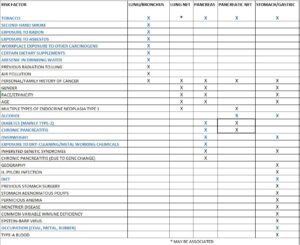In recognition of November as Lung, Pancreas, Stomach, and Neuroendocrine Cancer Awareness Month, and in our continuing effort to help shine light on the benefit of cancer registries, we would like to examine the risk factors among these four cancer sites based on information from the American Cancer Society (ACS). The American Cancer Society is one of many organizations that utilize cancer registry data items provided by Certified Tumor Registrars (CTR) from around the nation to help identify risks factors.
Certified Tumor Registrars (CTR) are, as stated by the National Cancer Registrars Association (NCRA): “… data information specialists that capture a complete history, diagnosis, treatment, and health status for every cancer patient in the U.S. The curated data provides essential information to researchers, healthcare providers, and public health officials to better monitor and advance cancer treatments, conduct research, and improve cancer prevention and screening programs.
Among the standard data items registrars collect are Demographics, Substance Use, Occupation, Personal History, and Comorbidities to name a few. As research dictates, CTRs will collect information on genetic and hereditary factors as special data items. These data items, among others (up to 250+), will be used for statistical analysis (both prospective and retrospective), to determine trends and research needs in the continuous fight against cancer. The collected data reflects the patient’s journey from diagnosis through treatment and lifetime follow-up. In the USA for the year 2020, 1.6 million new cancer cases have been added by the help of 6500+ cancer registry professionals dedicated to collecting these cancer data items.
The ACS has published the estimated number of new cancer cases and deaths in the current year for the total USA and individual states in its annual Cancer Facts & Figures publication since 1952 and in Cancer Statistics since 1970. The ACS estimates include the number of new cancer cases and deaths for each year, and provide the most recent statistics on cancer incidence, mortality, and five-year relative survival. They also track data regarding behaviors that influence the risk for development of cancer and the use of screening tests. Cancer Facts & Figures includes sections on cancer risk factors such as tobacco use, physical activity, and use of cancer screening examinations. The methods used to produce these estimates have changed over the years as data incidence and statistical models improved.1 (National Cancer Registrars Association, Inc., 2011, p. 14)
In the table below, we organized the. The “modifiable” risk factors are highlighted in blue. These factors are readily changeable by individuals in their day-to-day life. More detailed information about each risk factor can be found on the ACS website: https://www.cancer.org as of 10/20/23 under each specific cancer type “Causes, Risk Factors and Prevention > Risk Factors” webpage.
